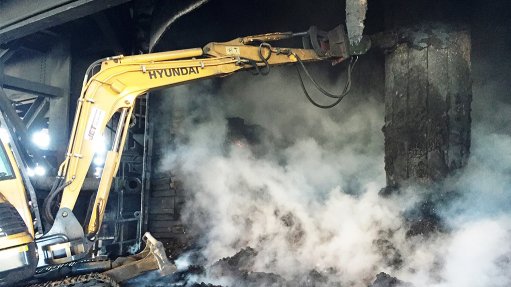
INSIDE JOB Jet Demolition offers solutions to work inside confined spaces such as on furnaces
Demolition solutions provider Jet Demolition has steadily expanded its fleet of equipment to befit projects that facilitate relines and repairs on furnaces and kilns of all types.
Furnace demolition projects generally represent a smaller proportion of the company’s scope, as furnace demolition services are required only under emergency conditions or during planned shutdowns, adds Jet Demolition contracts manager Kate Bester.
These shutdowns are planned on a yearly basis, with the larger blast furnaces only requiring significant relines or repairs every few years.
“However, although the work we do under these shutdown conditions is limited, it is notoriously intense,” she tells Mining Weekly.
Bester points out that working within these generally confined spaces limits the type and size of equipment that can be used, and also calls for creativity and lateral thinking to facilitate an early startup and condensed work schedule.
Further, Jet Demolition’s teams are highly trained and experienced in terms of using the company’s machinery portfolio and are, therefore, well-equipped to negotiate the challenging conditions associated with furnace-related projects.
“We have a range of specialised tool carriers that are equipped with demolition tools to allow for and facilitate the different aspects of these projects,” she adds.
Some of the machines have been modified and equipped with tools specifically for furnace demolition projects to meet the requirements identified in previous projects.
Bester says Jet Demolition remains focused on mechanisation, where practicable, to separate employees from risk and improve the safety profile of any project the company undertakes.
Projects can present not only limited space and extreme temperatures but also restricted lighting, further highlighting the importance of deploying teams that are experienced and well versed in the challenges that might be encountered.
Additionally, it is not uncommon for various contractors to share a common working space, consequently increasing the risk to a project, owing to close contractor-interface, which can only be mitigated by detailed and committed upfront planning.
“We consider the upfront planning and preparation for challenging shutdowns as one of our most valuable resources,” she enthuses.
With thorough and detailed planning and preparation, the risk profile of the project improves, as does communication with all stakeholders.
“Forward thinking ultimately builds a stronger team, all working towards the common goal of getting the client up and running, as soon as possible.”
She adds that the company’s primary consideration is to understand the activities beyond the demolition scope that may impact on a project.
“Once the dynamics are wholly understood and unpacked, we can then proceed to determine the approach to the works, with consideration to access, density of persons within the work area, available space and the client’s shutdown schedule,” Bester concludes.